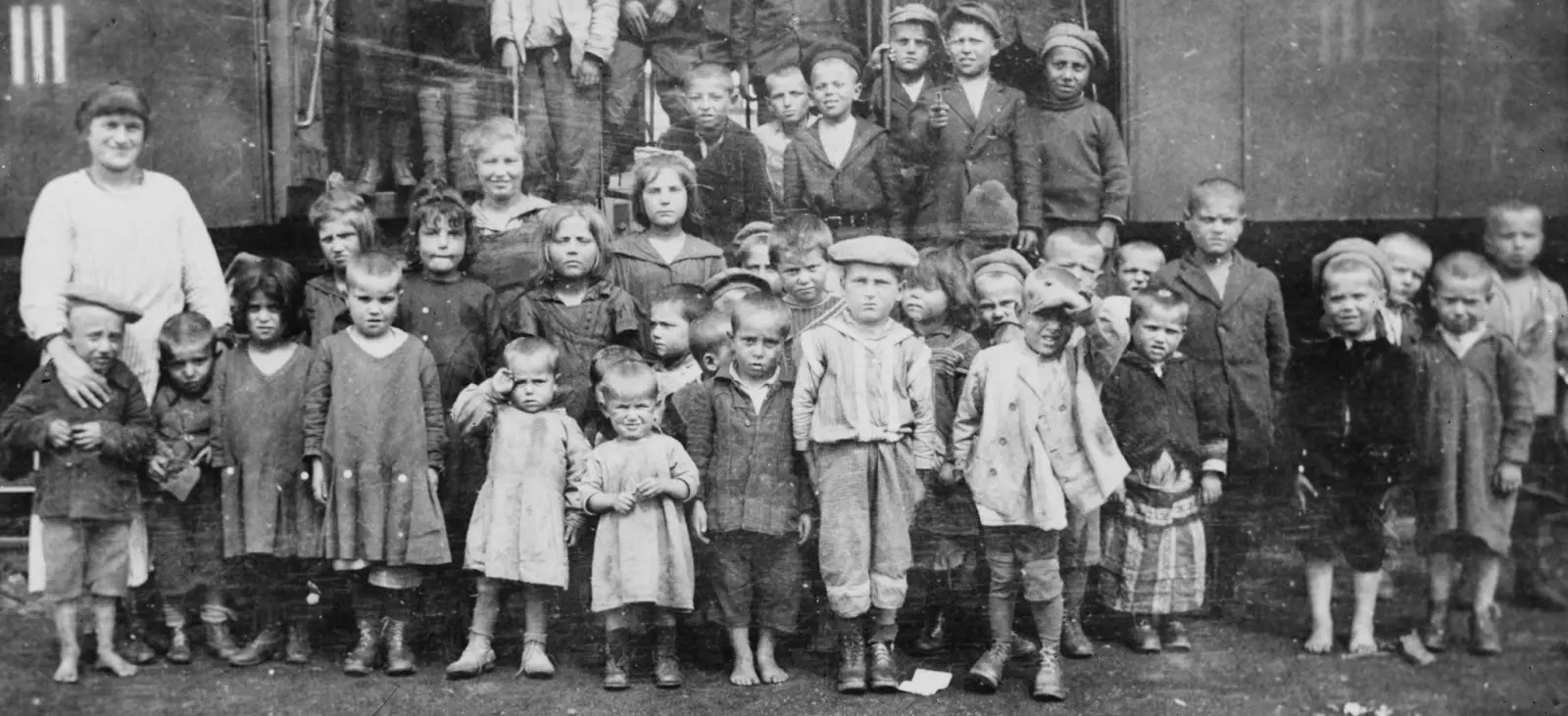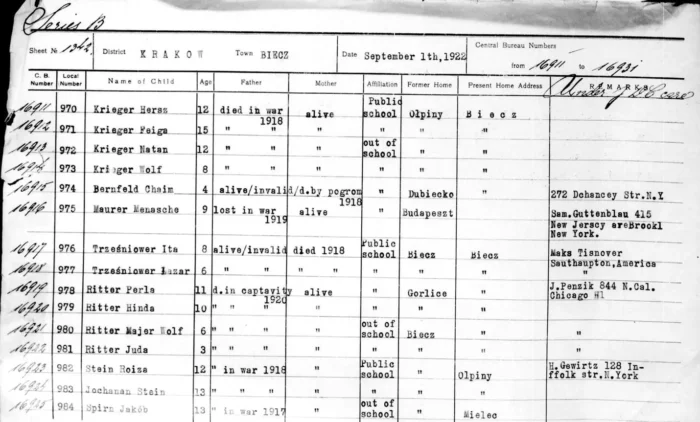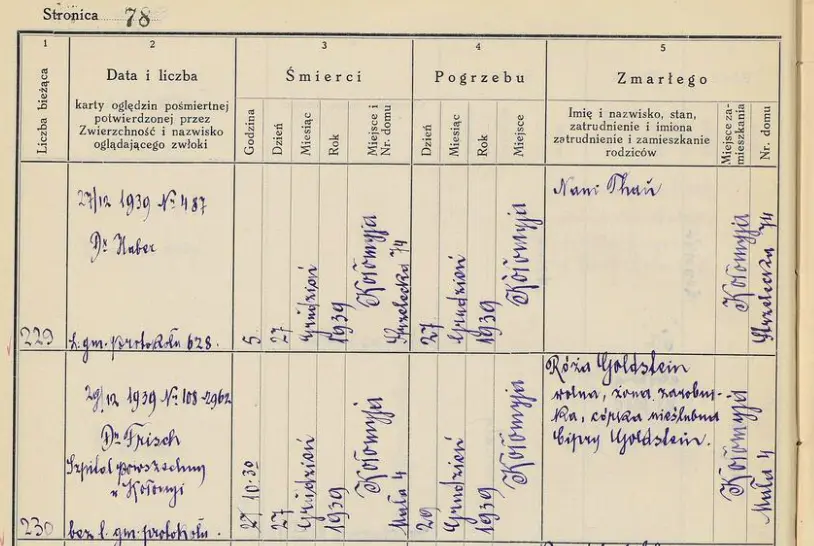The War Orphans Bureau Project
Project Coordinator: Alexander Feller
The War Orphans Bureau Project
Project Coordinator: Alexander Feller
After World War I, the American Jewish Joint Distribution Committee (JDC) established the War Orphans Bureau to aid thousands of European Jewish children who had lost one or both parents. Many of these children lived in devastated towns across former Galicia.
A key function of the Bureau was creating detailed orphan lists to manage aid distribution and track each child’s needs. These lists were compiled at the town level through local networks of rabbis, teachers, orphanages, and relief workers. Each entry included the child’s name, age, birthplace, parents’ status, guardian, physical condition, and educational background. Children were classified as full orphans, half-orphans, or displaced, helping prioritize the level of assistance. The lists enabled the Bureau to provide stipends, clothing, food, education, and medical care. They were updated regularly and submitted to the JDC’s headquarters for monitoring and planning. Orphan lists also supported efforts to reunite children with relatives, and when available, included addresses of relatives abroad. These records were vital for accountability and long-term care coordination.
Today, the lists serve as valuable historical resources documenting Jewish communal rescue efforts and as important genealogical records on Galician children and their parents. Given the disruption to vital record keeping during World War I, these lists can provide information of a deceased parent’s year and cause of death which may not be recorded elsewhere. This project transcribed orphan and parental information from lists for towns of former Galicia into a format that will allow members to search names in the All Galicia Database.

Photo Credit: Library of Congress
Archival Source
Records for the War Orphans Bureau are found online in the archive of the YIVO Institute for Jewish Research on the Center for Jewish History website. The collection titled “Records of the Joint Distribution Committee War Orphans Bureau” is located within Record Group 335.3. Folders within this record group which contain orphan lists for Galician towns are Folders 188-190, and 205. Labels and links to these folders are:
- Reel 15.186, Folder 188 labelled Lists: Lemberg District R-Z
- Reel 15.186, Folder 189 labelled Lists: Lemberg District K-R
- Reel 15.186, Folder 190 labelled Lists: Lemberg District B-K
- Reel 15.177, Folder 205 labelled List: Lwów area
Documents regarding the general plan and procedure of the War Orphans Bureau can be found online on the JDC website within the collection titled “Child Care, War Orphans Bureau, 1920-1921” (Item ID 214084, Reference Code NY AR191921/3/1/88.2). This collection includes correspondence, reports on establishment, activities of the War Orphans Bureau since opening in November 1920, and procedures for financial adoption.
Archival Content
The standardized preprinted forms used by the War Orphans Bureau in creating orphan lists contain headings that are in English. Information that was entered on these forms were mainly typewritten although some were handwritten. Lists are organized by town and their corresponding regional “district” center which for towns in former Galicia included Lwów (Lemberg), Kraków (Krakau) and Przemyśl. Each list was labelled with the name of the town, their corresponding “district”, a sheet number and a date. Data in this record set was gathered from May 18, 1920, to January 30, 1923 and includes information on 3834 children ranging in age from 4 months to 19 years old from 162 different towns across Galicia. The column headings for each orphan entry are titled Central Bureau Number, Local Number, Name of Child, Age, Father, Mother, Affiliation, Former Home, Present Home Address, and Remarks. A description of how each column heading was used to collect information is described below:
- Central Bureau (C.B.) Number: Each orphan was assigned a unique number which likely was used at the administrative level to identify a specific child within all European orphans. C.B. numbers in this record set range from 2482 to 17610 with gaps in the sequence likely corresponding to missing sheets.
- Local Number – Each orphan was assigned a number that was unique within the district corresponding to the town. Local numbers found in this project ranged from 7 to 1037 for Kraków (Krakau), ranged from 92 to 4863 for Lwów (Lemberg), and ranged from 772 to 1087 for Przemyśl.
- Name of Child – The first and last name was written for each child.
- Age – The age of the child in years was written.
- Father/Mother- If the parent was deceased, the letter “d” was usually written followed by the cause and year of death. If the parent was not deceased, the field may include their occupation, their financial state, or their health status. The letter “l” was also used to note that the parent was living.
- Affiliation – When this field was used, the type of school (public or private) was written or “out” if out of school.
- Former Home – The name of the town where the child lived before the war.
- Present Home Address – The name of the town where the child lived at the time of registration.
- Remarks – This field usually included the health status of the child, the grade in school the child attends or trade if working, known address of a relative, the number of children under the care of the living parent, whether the child was under the care of the JDC, or whether the child qualified for legal adoption.
- Handwritten notes – Occasionally, a handwritten note was written over an entry. This note was either “Record Made” or “Cancelled”. “Record Made” was typically abbreviated to “Rec Made” when used. A notation of “Cancelled” also included a strike through the entry as well. The reason these notations were made is unknown.

Benefits to Researchers
World War I was a turbulent time for many towns within the former province of Galicia. Death, disease, and poverty affected almost every family. Men were called up to be soldiers by the Austro-Hungarian Army, deported into Russia by the Russian Army, or died because of disease or war. Mothers and their children were left to survive in their hometown or relocated to other towns. Given the disruption in vital record keeping due to the war, and the movement of families, this period presents a challenge to genealogists in tracing the whereabouts and disposition of family members. These records provide information on children and their parents in the aftermath of World War I that can fill in those gaps. Information on a child’s birth year and birthplace can be used to locate birth records or add vital information where birth records no longer exist. Information on a parents’ death or health status provides additional data to better understand the fate of a child’s parents during the war that was otherwise frequently unknown. Names and addresses of relatives abroad mentioned in these lists may help connect previously unknown relations.
Acknowledgements
Gesher Galicia acknowledges Efrat Laksman for volunteering her time and effort transcribing many of these records into a database for incorporation into the All Galicia Database. Gesher Galicia also thanks the YIVO Institute for Jewish Research in New York for their permission to index and display these records in cooperation with our mission to provide genealogical data to researchers.
Questions. Please direct questions to: info@geshergalicia.org


